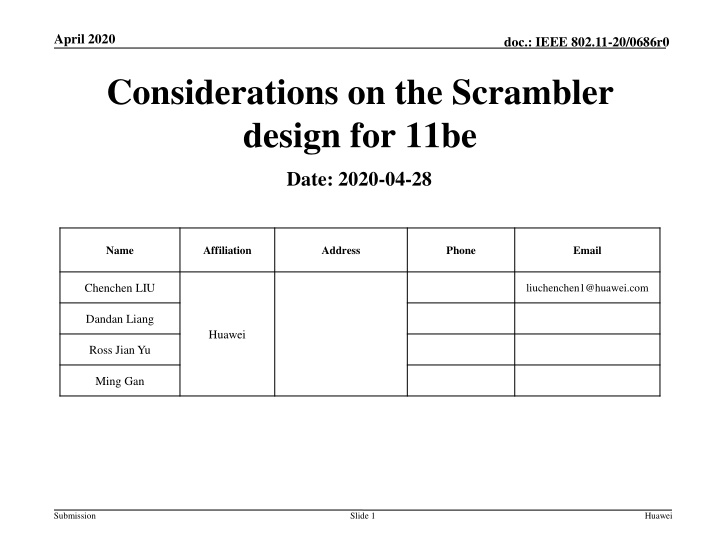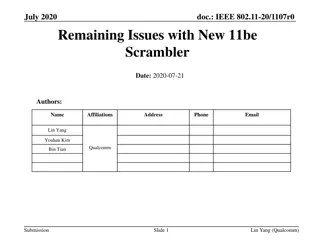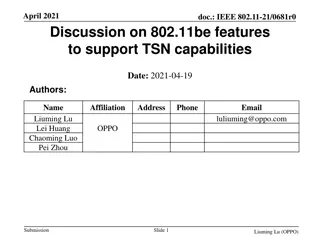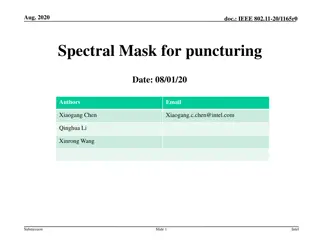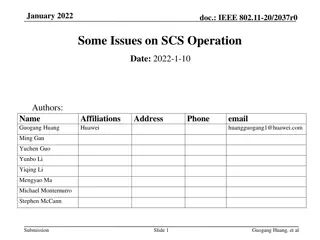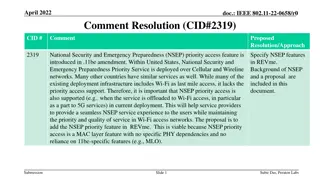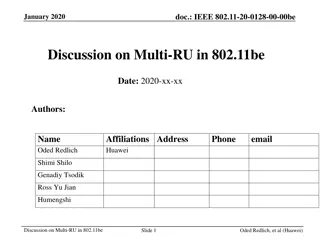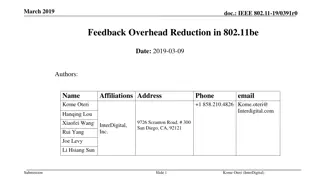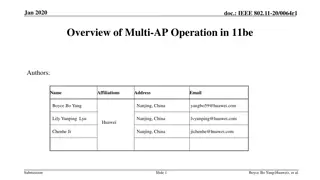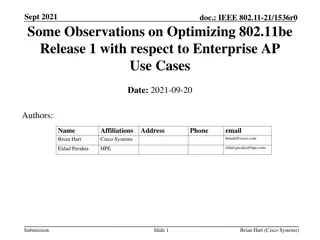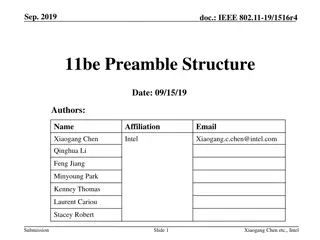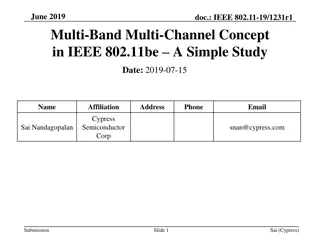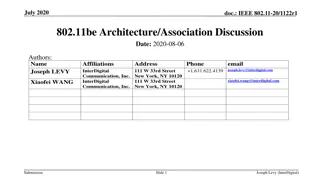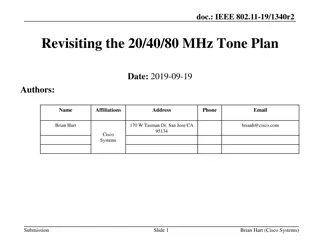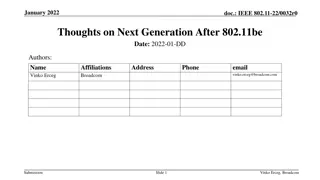Consideration on the scrambler design for 11be
Discussion and proposal of a scrambler for IEEE 802.11be, focusing on design principles, high-order scrambler pros and cons, and a proposed solution to address the periodic source signal issue for larger bandwidth. The document outlines the current scrambler in IEEE 802.11, challenges faced, and references for further exploration.
Uploaded on Feb 23, 2025 | 1 Views
Download Presentation

Please find below an Image/Link to download the presentation.
The content on the website is provided AS IS for your information and personal use only. It may not be sold, licensed, or shared on other websites without obtaining consent from the author.If you encounter any issues during the download, it is possible that the publisher has removed the file from their server.
You are allowed to download the files provided on this website for personal or commercial use, subject to the condition that they are used lawfully. All files are the property of their respective owners.
The content on the website is provided AS IS for your information and personal use only. It may not be sold, licensed, or shared on other websites without obtaining consent from the author.
E N D
Presentation Transcript
April 2020 doc.: IEEE 802.11-20/0686r0 Considerations on the Scrambler design for 11be Date: 2020-04-28 Name Affiliation Address Phone Email Chenchen LIU liuchenchen1@huawei.com Dandan Liang Huawei Ross Jian Yu Ming Gan Submission Slide 1 Huawei
April 2020 doc.: IEEE 802.11-20/0686r0 Abstract In this contribution, we discuss and propose the scrambler for 11be. Submission Slide 2 Huawei
April 2020 doc.: IEEE 802.11-20/0686r0 Outline Recap of the current scrambler in 802.11; Problem of periodic source signal for larger BW; Scrambler design principles Pros vs Cons for a Higher order Scrambler; Proposed solution References. Submission Slide 3 Huawei
April 2020 doc.: IEEE 802.11-20/0686r0 Recap of the current scrambler in 802.11[1] Initialization bits Data in G X = ?7+ ?4+ 1 7 6 5 4 3 2 1 Scrambled Data out 00001110 11110010 11001001 00000010 00100110 00101110 10110110 00001100 11010100 11100111 10110100 00101010 11111010 01010001 10111000 1111111, when the all 1s initial state is used The scrambler repeats every 127 bits; The phase of the scramble sequence produced is determined by the initial state of the scrambler The receiver needs to know the initial state of the scrambler for producing the identical sequence to descramble the data. Submission Slide 4 Huawei
April 2020 doc.: IEEE 802.11-20/0686r0 Problem of periodic source signal for larger BW To avoid the high PAPR problem, the repetition is not expected within one OFDM symbol There can be hundreds of repetition within one OFDM symbol with scramble sequence of period of 127(16333/127) 320MHz and 4096QAM are the main features in 11be, therefore a higher degree(maybe 17) scrambler is required. Submission Slide 5 Huawei
April 2020 doc.: IEEE 802.11-20/0686r0 Scrambler design principles The generator polynomial should be primitive [2] To make it simple, the primitive polynomial with the least non-zero term is preferred(minimum number of terms 3) Considering the reversal property, there is always a dual scrambler design The initialize bits can be reduced(already done in 11ac) A full list of scrambler satisfying the first two constrains within degree range from 8 to 32 is given in the following slides(without considering the dual) Submission Slide 6 Huawei
April 2020 doc.: IEEE 802.11-20/0686r0 Scrambler design principles Degree 9: Degree 10: Degree 11: Degree 15: Degree 17: Degree 18: Degree 20: Degree 21: Degree 22: Degree 23: Degree 25: Degree 29: Degree 31: S ? = ?9+ ?5+ 1 S ? = ?10+ ?7+ 1 S ? = ?11+ ?9+ 1 S ? = ?15+ ?11+ 1; S ? = ?15+ ?8+ 1 S ? = ?15+ ?14+ 1; S ? = ?17+ ?14+ 1; S ? = ?17+ ?12+ 1; S ? = ?17+ ?11+ 1 S ? = ?18+ ?11+ 1 S ? = ?20+ ?17+ 1 S ? = ?21+ ?19+ 1 S ? = ?22+ ?21+ 1 S ? = ?23+ ?18+ 1 S ? = ?25+ ?22+ 1 S ? = ?29+ ?27+ 1 S ? = ?31+ ?28+ 1 Submission Slide 7 Huawei
April 2020 doc.: IEEE 802.11-20/0686r0 Pros vs Cons for Higher order Scrambler Pros Reducing the PAPR for larger BW with non-random data Only one consistent scrambler for all PPDU Cons Applying higher degree scrambler may cause large PAPR problem for narrowband PPDU, since high order scrambler means more long run(a run of length r to be a sequence of r consecutive identical numbers, for ? degree scrambler, there are 2? ? 1 runs of length ? , for ? = 1,2, ) Non-random data will not give rise to large PAPR problem for narrowband PPDU The low cost device may not want to make the changes The 11be device needs to implement the old scrambler for the coexistence of legacy STAs Submission Slide 8 Huawei
April 2020 doc.: IEEE 802.11-20/0686r0 Simulations Simulation Assumptions: RU Size: 106, 242, 484, 996; MCS: 0, 1SS; LDPC; All zeros data Scrambler of order 7, 11, 15 with the following generator polynomial S ? = ?7+ ?4+ 1 S ? = ?11+ ?9+ 1 S ? = ?15+ ?14+ 1 Submission Slide 9 Huawei
April 2020 doc.: IEEE 802.11-20/0686r0 Simulation Results RU106 RU242 RU996 RU484 Submission Slide 10 Huawei
April 2020 doc.: IEEE 802.11-20/0686r0 Simulation Results From the simulation results, it can be observed that High degree scrambler will increase the PAPR for small RU size. The CDF of high degree scrambler has a longer tail, i.e. some of the packet may suffer from very large PAPR which lead to the failure of transmition. The higher degree scrambler can have work well when RU size >=996. Submission Slide 11 Huawei
April 2020 doc.: IEEE 802.11-20/0686r0 Proposed Solution: Adaptive Scrambler [3] proposed the scrambler with , while we propose to use an adaptive scrambler with respect to the RU size and MCS. S ? = ?11+ ?9+ 1 e.g. For RU size size(or combined RU size ) <996, the original scrambler is used. For RU size(or combined RU size ) between 996 to 2*996, the 11 degree scrambler used (can also use 15 degree scrambler instead to make it simple) For RU size(or combined RU size )>2*996, 15 degree scrambler is used RU Size&MCS S Initialization bits S MUX S Data in 15 14 13 12 11 10 9 8 7 6 5 4 3 2 1 Scrambled Data out The low order scrambler can reuse the hardware resource of high order scrambler The transmitter determines which scrambler will be used base on the RU size and MCS RU size for UL MU PPDU, BW for SU PPDU, TBD for DL MU PPDU, TBD for Puncture With this adaptive scrambler, the low-cost device does not need to implement the high order scrambler Submission Slide 12 Huawei
April 2020 doc.: IEEE 802.11-20/0686r0 Summary In this contribution, considering the backward compatibility and reducing PAPR, we propose the adaptive scrambler for 11be and different BW can apply Scrambler of different degree. Submission Slide 13 Huawei
April 2020 doc.: IEEE 802.11-20/0686r0 SP Do you agree to use higher degree scrambler only for user with large RU size and high MCS in EHT PPDU? The exact high degree scrambler is TBD The condition when the high degree scrambler should be used is TBD Submission Slide 14 Huawei
April 2020 doc.: IEEE 802.11-20/0686r0 References [1] IEEE P802.11-REVmdTM/D3.0 [2] https://en.wikipedia.org/wiki/Primitive_polynomial_(field_theory) [3]11-20-0563-00-00be-eht-ppdu-scrambler [4] 11-10-1281-01-00ac-bw-and-static-dynamic-indication-within-legacy [5] 15-09-0727-00-0007-scrambler-and-fec-for-vlc Submission Slide 15 Huawei
April 2020 doc.: IEEE 802.11-20/0686r0 Backup Submission Slide 16 Huawei
April 2020 doc.: IEEE 802.11-20/0686r0 Backup Adaptive scrambler is 12 order Submission Slide 17 Huawei
April 2020 doc.: IEEE 802.11-20/0686r0 backup MCS=4, Submission Slide 18 Huawei
April 2020 doc.: IEEE 802.11-20/0686r0 ?????for 1ss 0 1 2 3 4 5 6 7 8 9 10 11 26-tone RU 6/12 12/24 36 24/48 36/72 96 108 120 144 160 180 200 52-tone RU 12/24 24/48 72 48/96 72/144 192 216 240 288 320 360 400 106-tone RU 25/51 51/102 153 102/204 153/306 408 459 510 612 680 765 850 242-tone RU 58/117 117/234 351 234/468 351/702 936 1053 1170 1404 1560 1755 1950 484-tone RU 117/234 234/468 702 468/936 702/1404 1872 2106 2340 2808 3120 3510 3900 996-tone RU 245/490 490/980 1470 980/1960 1470/2940 3920 4410 4900 5880 6533 7350 8166 2*996-tone RU 490/980 980/1960 2940 1960/3920 2940/5880 7840 8820 9800 11760 13066 14700 16333 Submission Slide 19 Huawei
